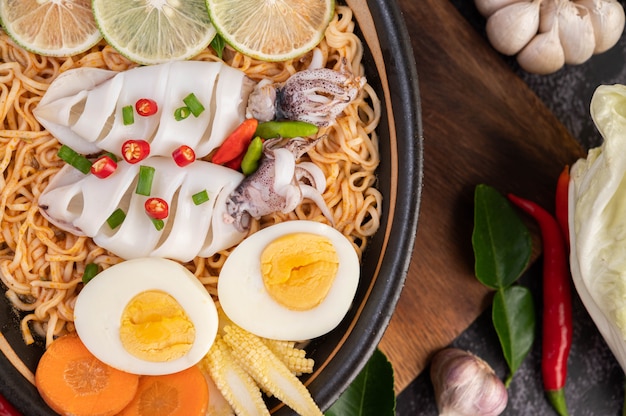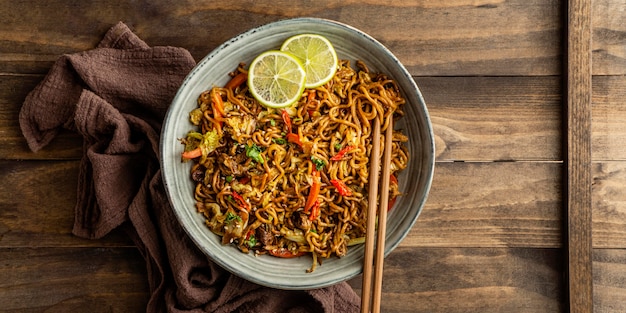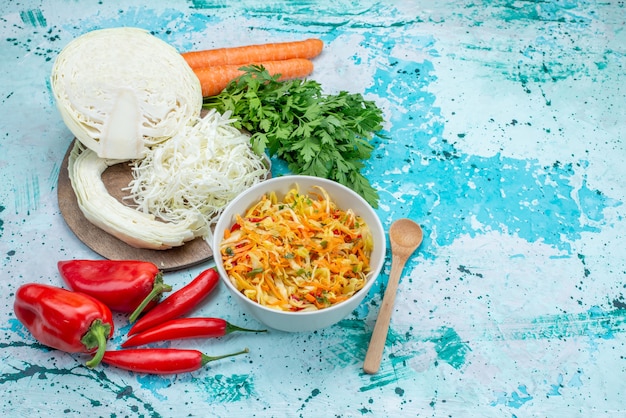I'll admit it, there's nothing quite like sinking your teeth into a plate of perfectly cooked Pad Thai. The sweet, tangy, and spicy notes dance on your tongue, while the soft, chewy noodles provide the perfect counterpoint. It's a dish that transports you to a bustling street food stall in Thailand, and it's a real treat to enjoy at home. But don't be intimidated by the thought of making it yourself! With this guide, you'll be whipping up restaurant-worthy Pad Thai in no time.
We'll cover everything from the essential ingredients and tools to the fine art of balancing flavours and achieving that perfect golden-brown finish. You'll discover a few tricks of the trade that I've picked up over the years, transforming your Pad Thai from good to truly exceptional. So, grab your wok, put on your apron, and let's dive in!
(Part 1) The Soul of Pad Thai

Pad Thai is more than just a dish; it's a cultural icon. As Thailand's national dish, it's a delicious reflection of the country's vibrant culinary history. It's believed to have originated during World War II, when the Thai government encouraged people to use rice noodles as a staple food. This clever move helped to alleviate rice shortages while simultaneously giving birth to a culinary masterpiece.
A Symphony of Flavours
The essence of Pad Thai lies in its harmonious blend of sweet, tangy, and spicy flavours. The sweetness comes from palm sugar, which offers a gentle, natural sweetness. Tamarind juice brings the tangy element, lending a sharp, citrusy note. And for a fiery kick, you'll find chilli flakes or fresh chillis.
But there's more to it than just these three components. Fish sauce adds a savoury depth and umami richness, while a squeeze of lime juice brightens the flavours and balances the sweetness. The finishing touch is a generous sprinkle of crunchy peanuts, offering a delightful textural contrast and adding a nutty, earthy dimension.
(Part 2) The Essential Ingredients and Equipment

A good Pad Thai is all about the right ingredients and the right tools. Don't worry, you don't need a fancy gourmet kitchen to make this delicious dish. Here's what you'll need:
Must-Have Ingredients
Rice Noodles: The star of the show! Look for flat rice noodles, also known as "rice paper" or "rice sheets." They're readily available in most supermarkets, often in the Asian aisle.
Tamarind Paste: This tangy treasure is the heart of the Pad Thai sauce. You'll find it in Asian supermarkets and even some mainstream grocery stores.
Palm Sugar: This natural sweetener adds a unique depth of sweetness to the sauce. Check the Asian aisle in your supermarket.
Fish Sauce: Essential for that umami punch. Look for it in the Asian aisle of your supermarket.
Garlic: A staple in any well-stocked kitchen, garlic adds a lovely depth of flavour.
Chilli Flakes: These add a touch of heat to your Pad Thai. Use as much or as little as you like, depending on your heat tolerance.
Lime: A fresh squeeze of lime juice adds a bright citrusy note that balances the sweetness and tanginess of the dish.
Spring Onions: These add a fresh, crisp flavour and a bit of visual appeal.
Peanuts: For that crunchy, nutty addition that elevates your Pad Thai.
Eggs: Essential for adding protein and richness.
Tofu: A delicious and versatile addition. Choose firm or extra-firm tofu for the best texture.
Bean Sprouts: These add a delightful crunch and fresh touch to your Pad Thai.
Essential Equipment
Wok: A wok is ideal for stir-frying, but a large frying pan will do in a pinch.
Wooden Spatula or Stir-fry Spatula: A must-have for tossing and stirring your ingredients.
Large Bowl: For soaking your noodles.
Colander: For draining your noodles.
Chopping Board: For prepping your ingredients.
Sharp Knife: For chopping and slicing.
(Part 3) Mastering the Noodles

The noodles are the foundation of a great Pad Thai. You want them to be perfectly cooked, not mushy or too firm. Here's how to get it right:
The Secret to Perfect Noodles
Soaking your rice noodles before cooking is a crucial step that ensures a delicious texture. It allows them to soften and prevents them from sticking together. Fill a large bowl with warm water, add the noodles, and let them soak for about 15 minutes, or until they become pliable.
After soaking, drain the noodles in a colander. Don't rinse them!
Heat a large pot of water to a boil. Add the noodles and cook for about 30 seconds, just until they are slightly softened. Drain them again and set aside.
The key here is to not overcook the noodles! We're aiming for a chewy texture, and we'll finish off the cooking process in the wok with the rest of the ingredients.
(Part 4) Prepping for Perfection
With your noodles soaking, it's time to prep the other ingredients. Here's my tried-and-true method:
1. The Pad Thai Sauce
The sauce is the heart and soul of your Pad Thai. You want a beautiful balance of sweet, tangy, and spicy. In a small bowl, whisk together:
2 tablespoons tamarind paste
2 tablespoons palm sugar
1 tablespoon fish sauce
1 tablespoon water
1 teaspoon chilli flakes (or more, to taste)
1 tablespoon lime juice
Taste and adjust the seasoning to your liking. I find that a little extra lime juice can really brighten up the flavour.
2. Proteins and Veggies
Tofu: Cut firm or extra-firm tofu into bite-sized cubes. Then, press it between two paper towels to remove excess moisture. Heat a small pan over medium heat and fry the tofu until golden brown and crispy on all sides. Set aside.
Eggs: Whisk together 2-3 eggs. Heat a small pan over medium heat and add a splash of oil. Pour the eggs into the pan and cook until they are just set but still slightly runny. Don't overcook the eggs.
Bean Sprouts: Wash and drain the bean sprouts. You can add them to the wok directly or give them a quick stir-fry in a separate pan for a few minutes.
Spring Onions: Chop the spring onions into thin slices.
(Part 5) The Art of Stir-Frying
Now it's time to bring everything together in a glorious stir-fry!
1. Heating the Wok
Heat your wok or frying pan over high heat. You want it piping hot to create a nice sear. Add a tablespoon or two of oil to the wok, swirling it around to coat the base.
2. Stir-Frying the Noodles
Add the drained noodles to the hot wok and toss them with the oil. Stir-fry for about a minute, just until they are heated through.
3. Adding the Flavour
Add the prepared sauce to the wok and toss it with the noodles, making sure to coat them evenly. Then add the tofu, eggs, and bean sprouts to the wok and stir-fry for another minute.
4. Final Touches
Scatter the chopped spring onions over the noodles and stir-fry for another 30 seconds.
5. Serving
Serve your Pad Thai immediately. Garnish with crushed peanuts, a squeeze of lime juice, and a sprinkle of chopped coriander. Enjoy!
(Part 6) Tricks of the Trade
Here are a few extra tips to help you create truly memorable Pad Thai:
1. The Power of Garlic
Don't underestimate the power of garlic. I always add a couple of cloves of minced garlic to my wok along with the noodles. It adds a beautiful depth of flavour and aroma.
2. The Magic of Sugar
To avoid a gritty texture in your Pad Thai, always dissolve the palm sugar in a little hot water before adding it to the sauce. It'll melt smoothly and integrate beautifully into the other flavours.
3. The Importance of Freshness
If possible, use fresh chillis instead of chilli flakes. It adds a more nuanced level of flavour and heat.
(Part 7) Beyond the Classic
Once you've mastered the basic Pad Thai recipe, it's time to get creative and explore different variations.
1. Vegetarian Delight
Swap out the tofu for other vegetarian proteins like tempeh, seitan, or mushrooms.
2. Seafood Sensation
Add shrimp, squid, or fish to your Pad Thai for a flavourful, protein-packed meal.
3. Spice it Up
For an extra kick, add a dollop of sriracha or gochujang to your Pad Thai.
4. A Touch of Creaminess
Add a spoonful of peanut butter to your sauce for a richer, creamier flavour.
5. Sweet and Savoury
Try adding a few slices of mango for a sweet and tangy twist on classic Pad Thai.
(Part 8) Storing and Reheating
Pad Thai is best enjoyed fresh, but if you have leftovers, you can store them in an airtight container in the fridge for up to 2-3 days.
Reheating Your Pad Thai
You can reheat your Pad Thai in a microwave, but the best way to bring back its flavour and texture is to stir-fry it in a wok or pan with a little oil.
FAQs
1. What is the best kind of noodles to use for Pad Thai?
The classic choice is flat rice noodles, often called "rice paper" or "rice sheets." You can also use round rice noodles, but they tend to be a bit more chewy.
2. Can I use regular sugar instead of palm sugar?
You can, but palm sugar has a more mellow sweetness that complements the other flavours in Pad Thai. Regular sugar might be a little too overpowering.
3. How do I make the sauce less spicy?
Start with a small amount of chilli flakes and add more if needed. You can also substitute a milder chilli pepper like jalapeno for the chilli flakes.
4. Can I add vegetables to my Pad Thai?
Absolutely! You can add chopped carrots, cabbage, or even broccoli to your Pad Thai.
5. How do I make a vegan Pad Thai?
Use a vegan fish sauce substitute, like soy sauce or tamari. Replace eggs with tofu scramble and use a plant-based alternative to the palm sugar, like coconut sugar or maple syrup.
There you have it, folks! I hope this guide has inspired you to embark on your own Pad Thai adventures. Remember, it's all about having fun and experimenting in the kitchen. So go ahead, get creative, and enjoy the journey!
Everyone is watching

How to Cook Frozen Lobster Tails Perfectly: A Step-by-Step Guide
RecipesLobster. Just the word conjures up images of lavish meals, special occasions, and a taste of luxury. But let's...

Pigs in a Blanket Cooking Time: How Long to Bake for Perfect Results
RecipesAh, pigs in a blanket. Just the name conjures up images of those delightful little parcels of crispy pastry en...

Pork Fillet Cooking Time: How Long to Cook It Perfectly
RecipesPork fillet, or tenderloin as it's sometimes called, is a real favourite in our house. It's so versatile, and...

The Ultimate Guide to Cooking Delicious Frankfurters
RecipesLet's face it, we all love a good frankfurter. It's a classic, simple, and always satisfying. But let's be rea...

Wolf Meat Recipes: A Guide to Cooking Wild Game
RecipesLet's be honest, you don't see wolf meat at your local butcher shop every day. It's a bit of a wild card, but ...
